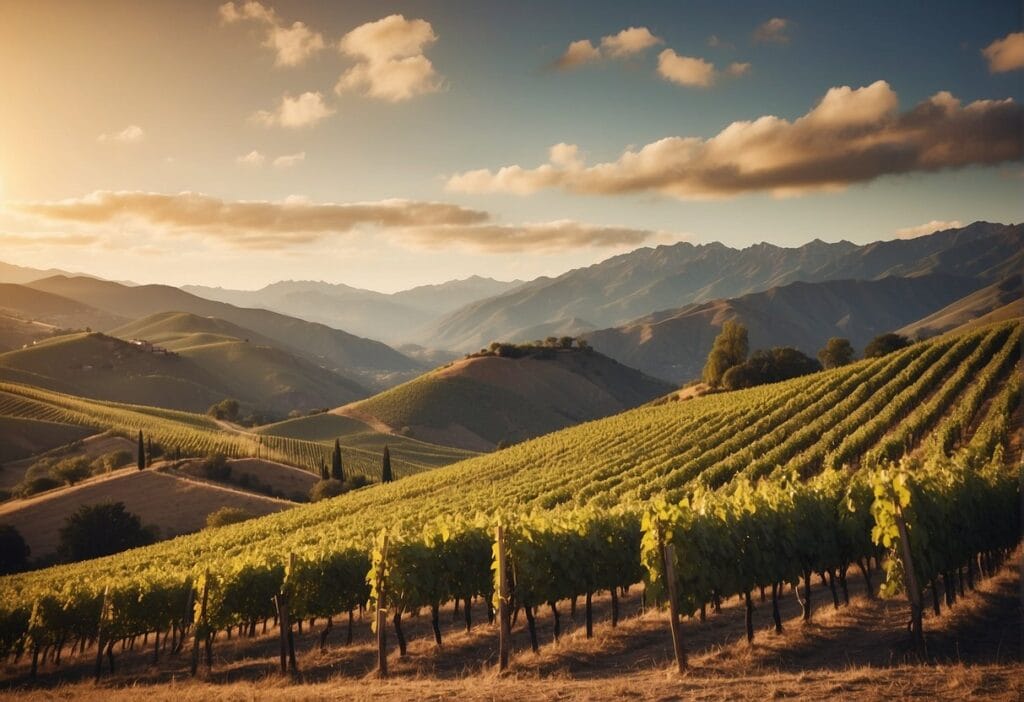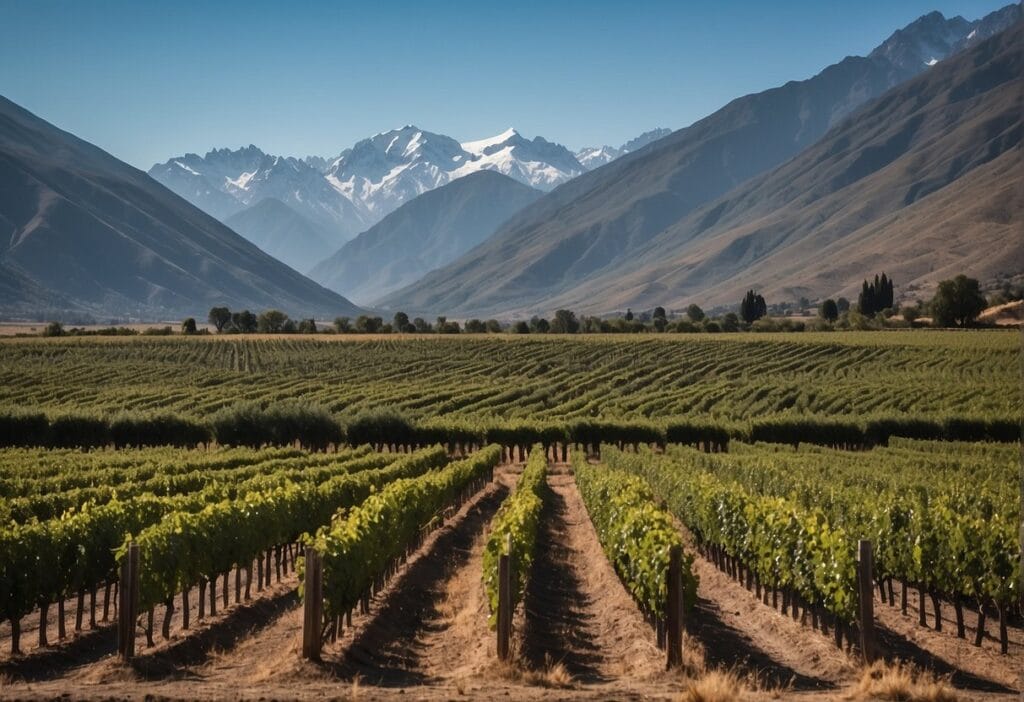Nestled in the heart of Italy, the Abruzzo wine region offers a blend of breathtaking landscapes and ancient winemaking traditions.
Its favorable geography and climate make it a unique haven for vineyards that stretch from the Apennine Mountains to the Adriatic Sea.
Here, you can discover a variety of grape varieties and wine styles that have put Abruzzo on the map.
The moderate climate, with its coastal influence and protective mountain barrier, creates an ideal environment for growing grapes that result in wines renowned for their flavor and quality.

In Abruzzo, winemaking has deep roots, with a history that intertwines with the region’s culture and economy.
The region is home to several appellations and regulations dedicated to ensuring the quality and authenticity of its wines.
Montepulciano d’Abruzzo, a bold red known for its plum-scented aroma and rich taste, is a testament to the region’s ability to produce world-class wines.
Traditional winemaking techniques are cherished and preserved, while innovative practices are adopted to maintain sustainability and embrace future trends.
With its array of notable wineries and vineyards, Abruzzo has become a prime destination for wine tourism, inviting enthusiasts to experience its viticulture first-hand.
Key Takeaways
- Abruzzo’s climate and geography create perfect conditions for distinctive wine styles.
- Tradition and innovation coexist in Abruzzo’s winemaking practices.
- Wine tourism thrives in Abruzzo, attracting visitors worldwide to its notable vineyards.
Geography and Climate
Exploring the Abruzzo wine region, you’ll find a diverse geography and a climate that greatly influences the area’s viticulture.
The Lay of the Land
Abruzzo is nestled in central Italy, bordered by the Marche, Lazio, and Molise regions.
To the east, it greets the Adriatic Sea, which has a coastline that runs from the province of Teramo down to Vasto.
Going westward, you’ll encounter the rugged terrain of the Apennines with Gran Sasso, the highest peak in the Apennines, as a dominant presence.
This mountainous spine of Italy divides the region into a coastal strip and the inner provinces of L’Aquila and partially Chieti.
Within the Apennines lies a myriad of National Parks that contribute to the area’s varying microclimates and diverse ecosystem.
The Altitude factor is significant here, defining each sub-zone’s unique viticultural profile.
Climate Influences
The climate in Abruzzo carries the hallmarks of both Mediterranean warmth from the Adriatic Coast and continental air from central Apennines.
The proximity to the coast in provinces like Pescara and Chieti ushers in moderate breezes, tempering the summer heat and nurturing grapes with a balance of sugar and acidity — ideal for wine production.
In contrast, L’Aquila, in the interior, experiences a more marked continental influence due to its higher altitude.
Here, the temperature variations between day and night can be dramatic, a feature that intensifies the aromas and flavors in the grapes.
The granitic and limestone-rich soils contribute complexity and minerality to the wines crafted in this region. Multiple microclimates, thanks to the varied geography, ensure that Abruzzo’s wines are as diverse as its terrain.
History of Winemaking in Abruzzo
Abruzzo’s winemaking heritage stretches back to ancient civilizations, with a marked evolution into the region’s modern techniques and recognitions today.
Ancient Roots
The Etruscans, a civilization predating Rome, were influential in introducing winemaking traditions to Abruzzo.
Evidence suggests that these practices date back to the sixth century BC.
Abruzzo’s winemaking managed to thrive despite the region’s relative isolation due to its challenging mountainous terrain, which helped to preserve unique viticultural methods, largely untouched by the Roman influence that was prominent in other parts of Italy.
Modern Developments
Over time, Abruzzo has embraced both tradition and innovation to cultivate its reputation in the winemaking world.
The region has combined time-honored methods with modern technologies to refine the quality and character of its wines.
This blend of old and new techniques has positioned Abruzzo as a wine region that honors its past while progressively forging its future identity within the global wine community.
Appellations and Regulations
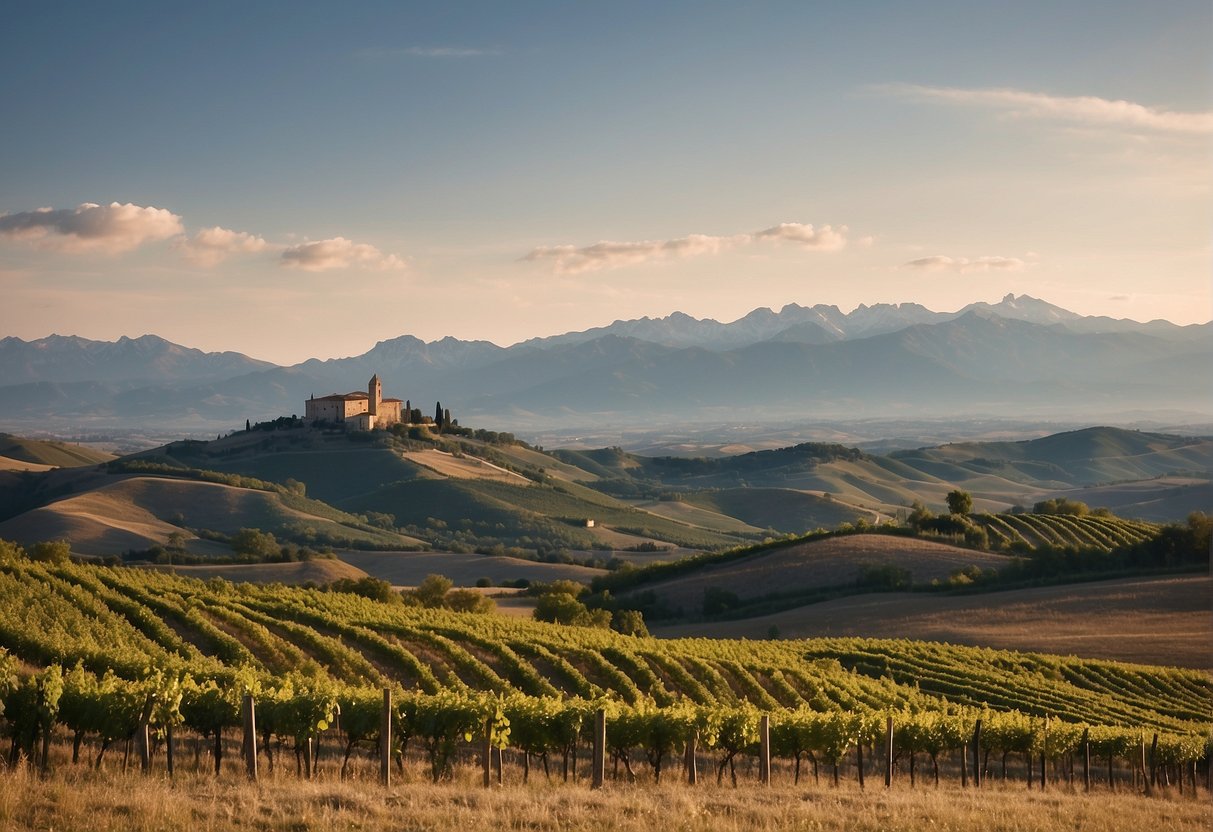
Understanding the appellations and their regulations is key to truly appreciating the wines from the Abruzzo region. These classifications not only assure the quality of the wine but also promote the uniqueness of the region’s produce.
DOC and DOCG Overview
Denominazione di Origine Controllata (DOC) and Denominazione di Origine Controllata e Garantita (DOCG) are quality assurance labels for Italian wines.
The DOCG designation stands higher than DOC, representing both controlled (as per DOC) and guaranteed origin status.
Wines under these classifications adhere to strict regulations that govern aspects like the geographical area, grape varieties, and winemaking practices.
Prominent DOCs in Abruzzo
Abruzzo is home to notable DOCs that spotlight the region’s winemaking diversity.
Montepulciano d’Abruzzo DOC is perhaps the most celebrated, known for producing rich, robust reds and the rosé, Cerasuolo.
Trebbiano d’Abruzzo DOC, focuses on crisp, delicately-flavored white wines.
The Cerasuolo d’Abruzzo DOC specifically produces rosé wines with a distinct cherry-red hue derived from the Montepulciano grape.
Another significant DOC, Colline Teramane, has earned the DOCG status for producing exceptional quality Montepulciano d’Abruzzo wines.
Lesser-known but emerging appellations such as Controguerra and Tullum (also known as Terre Tollesi or Tullum) further enrich the region’s winemaking repertoire.
Tullum, granted DOC status in 2008, is one of Italy’s smallest wine areas specializing in a range of wine styles.
Grape Varieties and Wine Styles
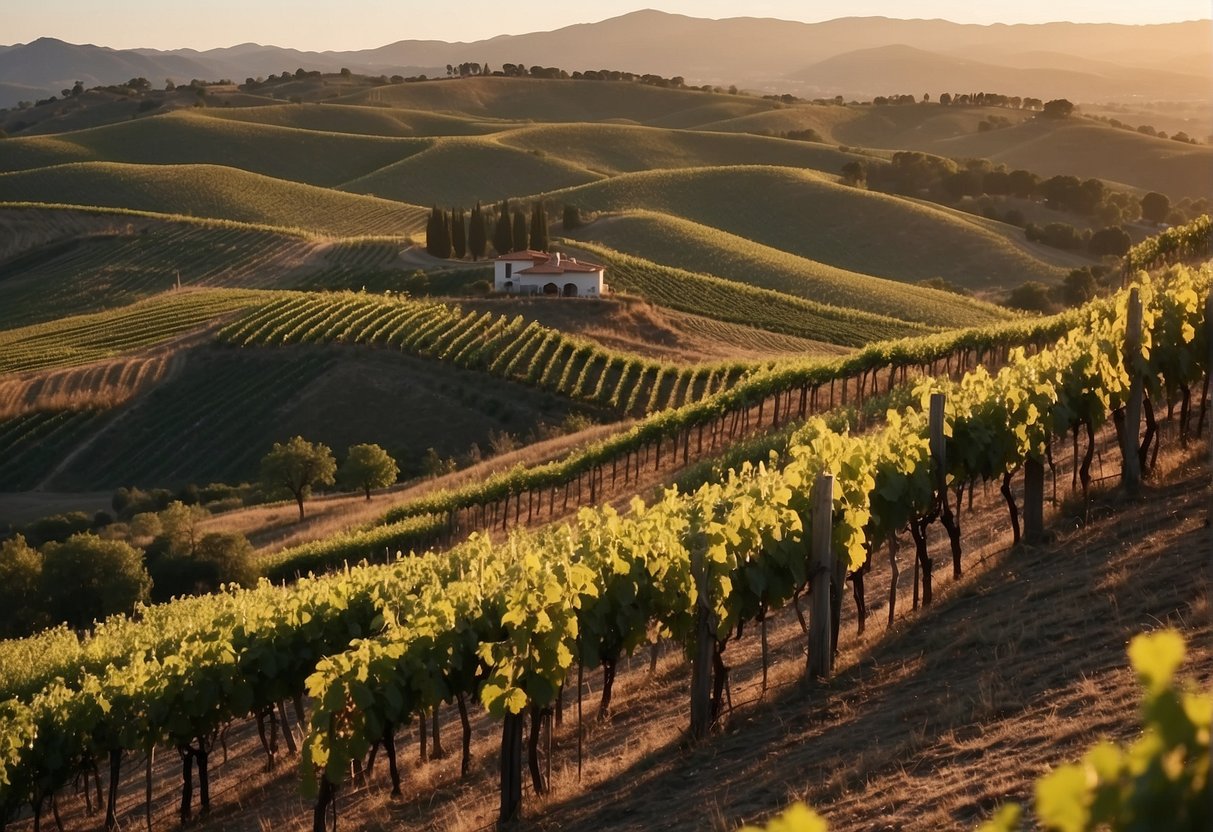
The Abruzzo wine region is renowned for its diverse array of grape varieties, offering you a wide range of flavors and distinctive styles in both red and white wines.
You’ll discover that the bold Montepulciano dominates the red variety, while the versatile Trebbiano shines among whites and rosés.
Red Varieties
In the heart of Abruzzo’s vineyards, the Montepulciano grape takes center stage, resulting in robust and full-bodied red wines.
Not to be confused with the similarly named Vino Nobile di Montepulciano from Tuscany, the Montepulciano from Abruzzo crafts the region’s flagship wine, Montepulciano d’Abruzzo, known for its deep ruby red color and berry flavors.
Your palate may also get the pleasure of experiencing wines with blends that incorporate other red varieties like the internationally acclaimed Cabernet Sauvignon, savory Merlot, and traditional Sangiovese.
White and Rosé Varieties
On the lighter side, Trebbiano d’Abruzzo Grape is key to producing refreshingly crisp white wines, noted for their citrus and floral characteristics.
Alongside Trebbiano, you’ll find the Pecorino grape, yielding white wines with a bold personality, often presenting minerality and herbal notes.
For rosé lovers, the Cerasuolo from Abruzzo offers a uniquely favored profile, which is a rosé version of Montepulciano that dazzles with its cherry pink hue and hint of almonds.
Local grape varieties such as Cococciola and Passerina extend the palette further, contributing to the subtle and refreshing whites and rosés that pair exquisitely with the region’s seafood dishes.
Winemaking Techniques
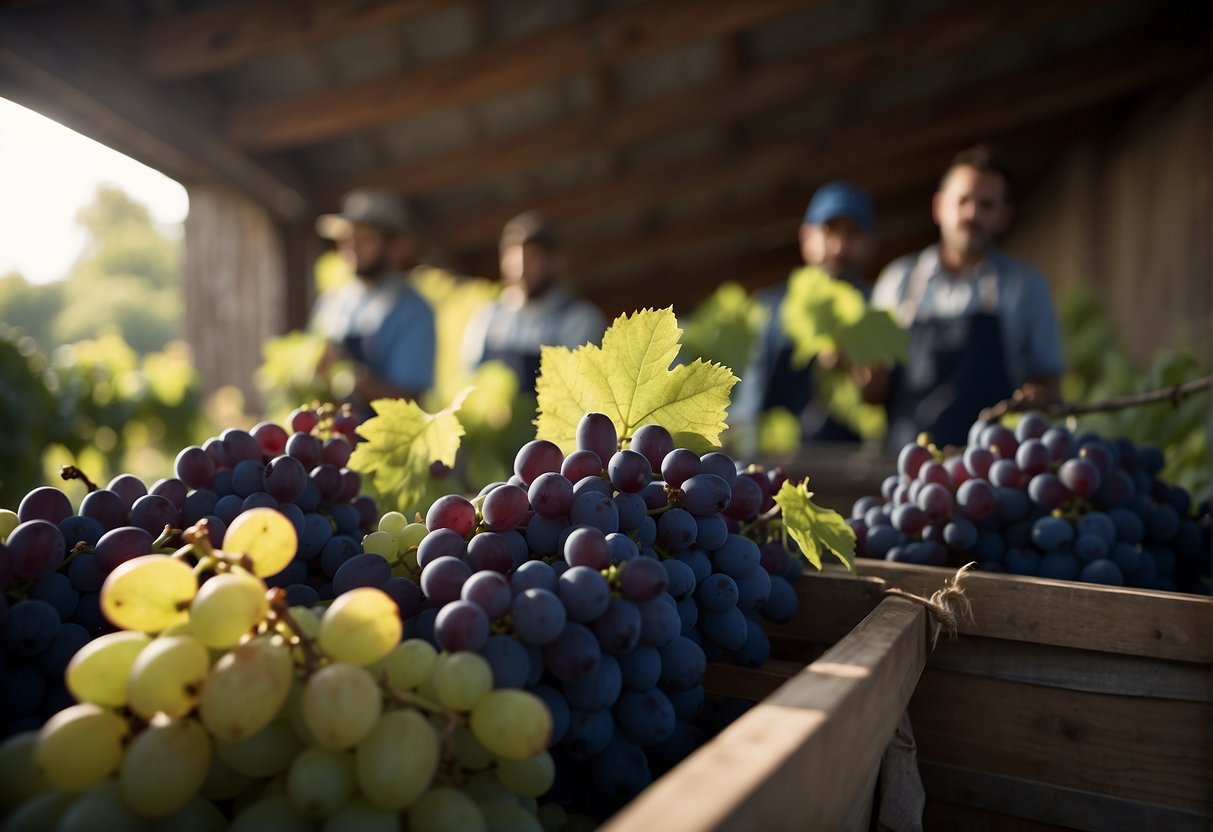
Exploring techniques reveals the delicate balance winemakers strike between tradition and modern innovation in Abruzzo.
Your understanding of the winemaking process is enhanced by taking a closer look at how these techniques impact the quality and uniqueness of the wines produced.
Traditional Methods
In Abruzzo, traditional winemaking techniques have been passed down through generations.
One key method includes the use of oak barrels for aging.
Oak aging contributes to the complexity, texture, and aroma of the wines, giving them a distinctive character that is cherished by enthusiasts around the world.
The use of organic farming practices is also prevalent, ensuring that vineyards thrive under the abundant sunshine the region receives, which is indispensable for the optimal ripening of grapes.
- Oak: Enhances flavors through aging.
- Organic Farming: Promotes vineyard health and wine quality.
Innovation in Winemaking
Innovations in winemaking allow Abruzzo’s vintners to refine their craft further.
Adaptation of stainless steel fermentation tanks is one such innovation.
These tanks provide winemakers with greater control over the fermentation process, leading to the production of fresher and fruitier wines.
Stainless steel is also beneficial for styles that do not need the influence of oak, preserving the grape’s pure flavors and aromas.
- Stainless Steel: Offers precise control, maintaining the fruitiness of wines.
- Sunshine: Careful management maximizes grape exposure for quality wine.
Notable Wineries and Vineyards
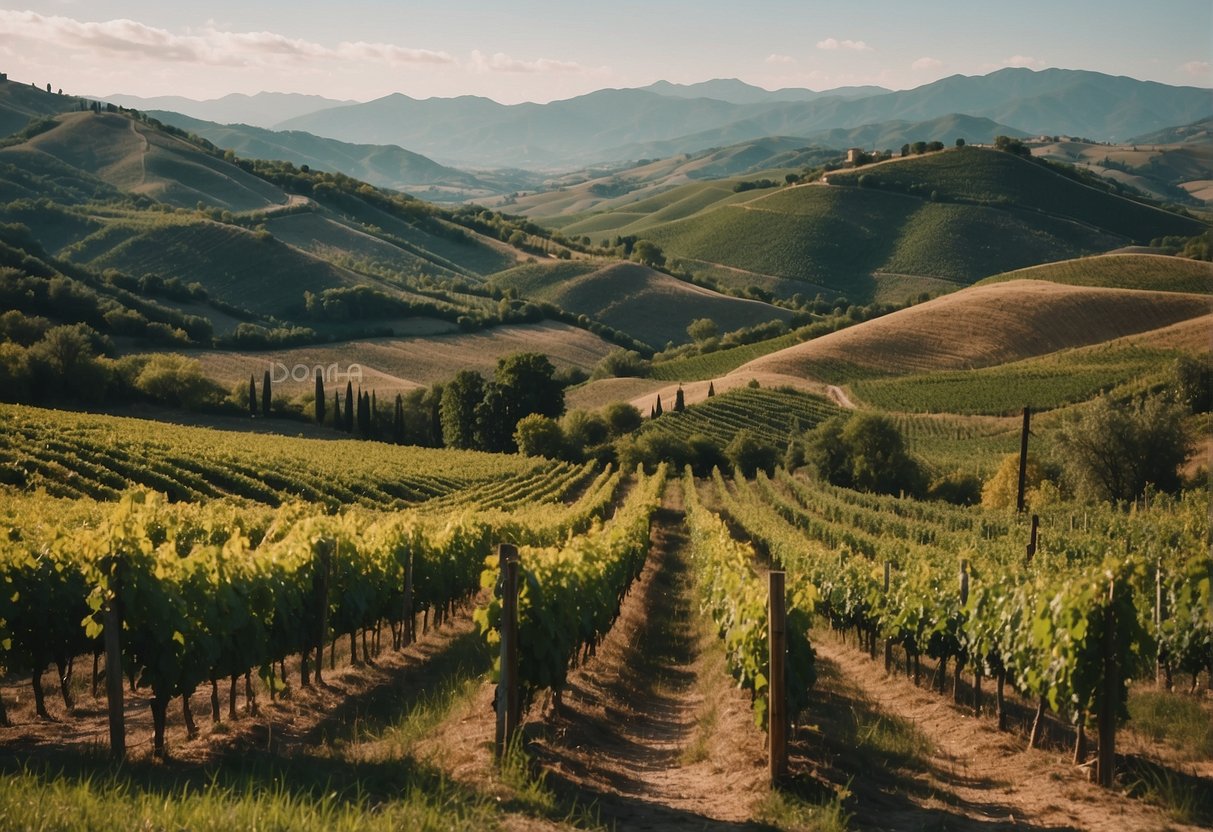
Abruzzo’s wine country is a landscape of tradition and innovation. Here, you can explore established estates with deep historical roots and rising stars that bring fresh perspectives to the rich winemaking heritage.
Established Estates
Among the venerable wineries of Abruzzo, Edoardo Valentini stands out for its exquisite wines that reflect a commitment to quality and tradition. This estate, known for its limited production and selective distribution, crafts wines renowned for their complexity and potential for aging.
Another noteworthy estate, Masciarelli, has played a pivotal role in putting Abruzzo on the wine world’s map. Founded by Gianni Masciarelli, its vineyards sprawl across the region, producing wines like the robust Montepulciano d’Abruzzo that exhibit the full potential of local varietals.
Cantina Tollo, a cooperative winery, has been instrumental in advancing the profile of Abruzzo’s wines. It consistently delivers a range of wines, including treasured DOC and DOCG labels, that showcase the variety and quality accessible to wine lovers at every level.
Rising Stars
As for the new wave of wineries, Castorani, co-founded by the former Formula One driver Jarno Trulli, infuses a spirit of innovation into each bottle, without losing touch with the region’s ancient traditions.
The boutique winery Pasetti is also making waves with its dedication to indigenous grapes and sustainable practices. Situated in rugged mountain territories, it breathes new life into the local winemaking scene, crafting both whites and bold reds that capture the essence of Abruzzo’s unique terroir.
Lastly, Casal Thaulero combines old-world charm with modern sensibilities, creating wines that appeal to both purists and modern wine drinkers. Their commitment to quality has made them a name to look out for in the dynamic landscape of Abruzzo’s wine scene.
Wine Tourism in Abruzzo
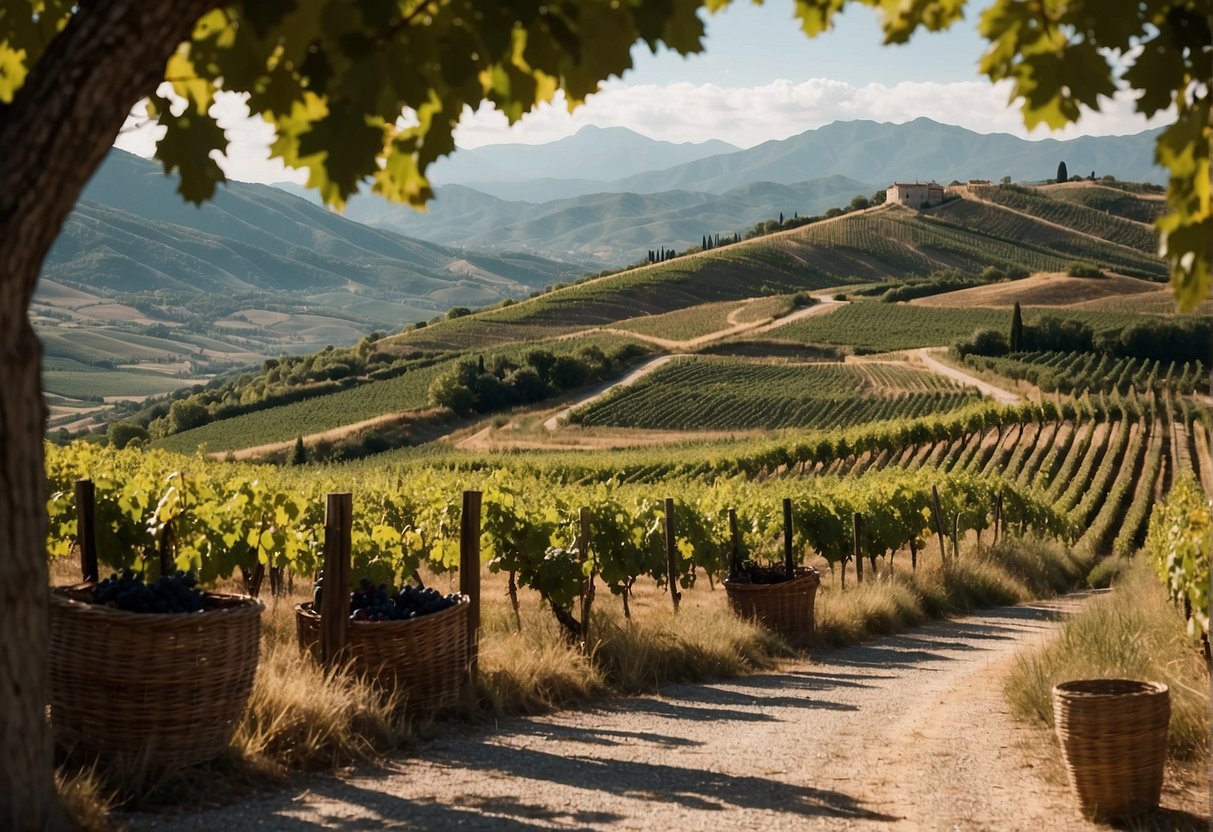
Embark on a delightful journey through the Abruzzo wine region, where you can immerse yourself in the world of Montepulciano and Trebbiano d’Abruzzo, and discover the unique Cerasuolo d’Abruzzo.
Winery Tours
As you explore the picturesque landscape of Abruzzo, you’ll find over 250 wineries that open their doors for intimate tours.
Navigating through vineyards nestled between the Adriatic Sea and the Apennines, you can experience the rich tradition of winemaking.
Each winery offers an insight into the cultivation of local grape varieties, most notably the flagship Montepulciano d’Abruzzo.
A must-visit is the Castorani winery, a remarkable 18th-century villa where organic practices meet historical charm.
Culinary Experiences
Pair your wine-tasting adventure with a foray into Abruzzo’s culinary delights.
The region’s wine culture is deeply intertwined with its gastronomy, offering a host of traditional dishes that beautifully complement the local wines.
You might indulge in a plate of ‘arrosticini’—succulent skewers of lamb—perfectly accompanied by a glass of robust Cerasuolo d’Abruzzo.
Look out for opportunities to join wine and food pairing sessions, where the fruity notes of Trebbiano d’Abruzzo shine alongside fresh Adriatic seafood.
The Global Reach of Abruzzo Wines
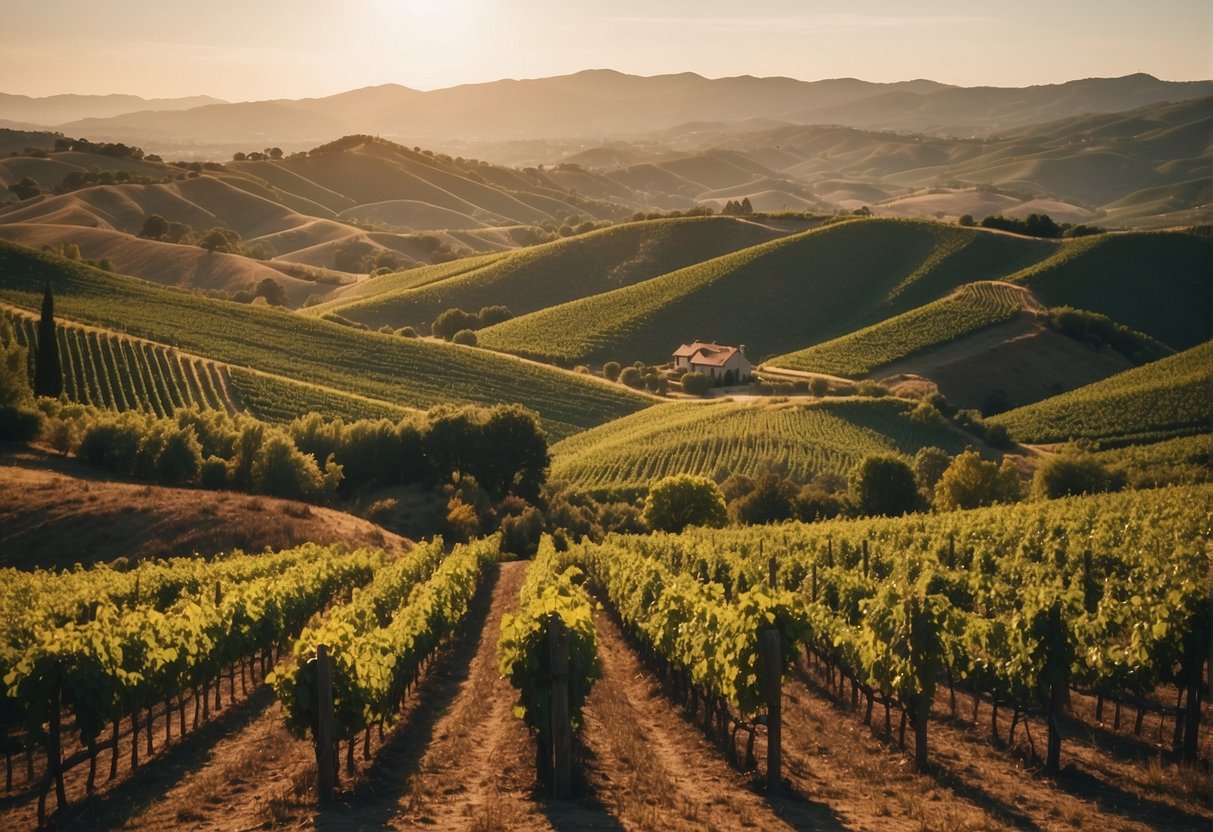
The Abruzzo wine region, a cornerstone of Italian viticulture, proudly exports its wines across the globe.
Your appreciation for wines might lead you to discover that many bottles in your local wine shop hail from this Italian gem.
Abruzzo’s international reputation is anchored by its signature grape variety: Montepulciano d’Abruzzo, which has found audiences far and wide.
You may find it intriguing to know that Abruzzo wineries have embraced both traditional and innovative practices, producing wines that resonate with a variety of palates.
As a result, the region’s exported wines showcase the perfect balance of richness and approachability, catered to suit any occasion, whether it’s a casual dinner or a festive celebration.
| Key Markets | Wine Styles |
|---|---|
| United States | Bold Reds |
| Canada | Crisp Whites |
| United Kingdom | Rosé Wines |
Abruzzo’s international reputation is not just limited to the wine itself; it encompasses the rich narrative of a wine culture that’s evolved over centuries.
You’ll often encounter stories about small family vineyards that contribute to the region’s wine mosaic, each bringing their unique touch to the wine’s flavor and character.
With every bottle of Abruzzo wine you enjoy, you’re not just savoring a regional treasure, but joining a global community of wine lovers united by their admiration for this Italian wine region.
So, next time you select a wine, consider the world-reaching influence of the Abruzzo wine region, a testament to Italy’s enduring legacy in winemaking.
Sustainability and Future Trends
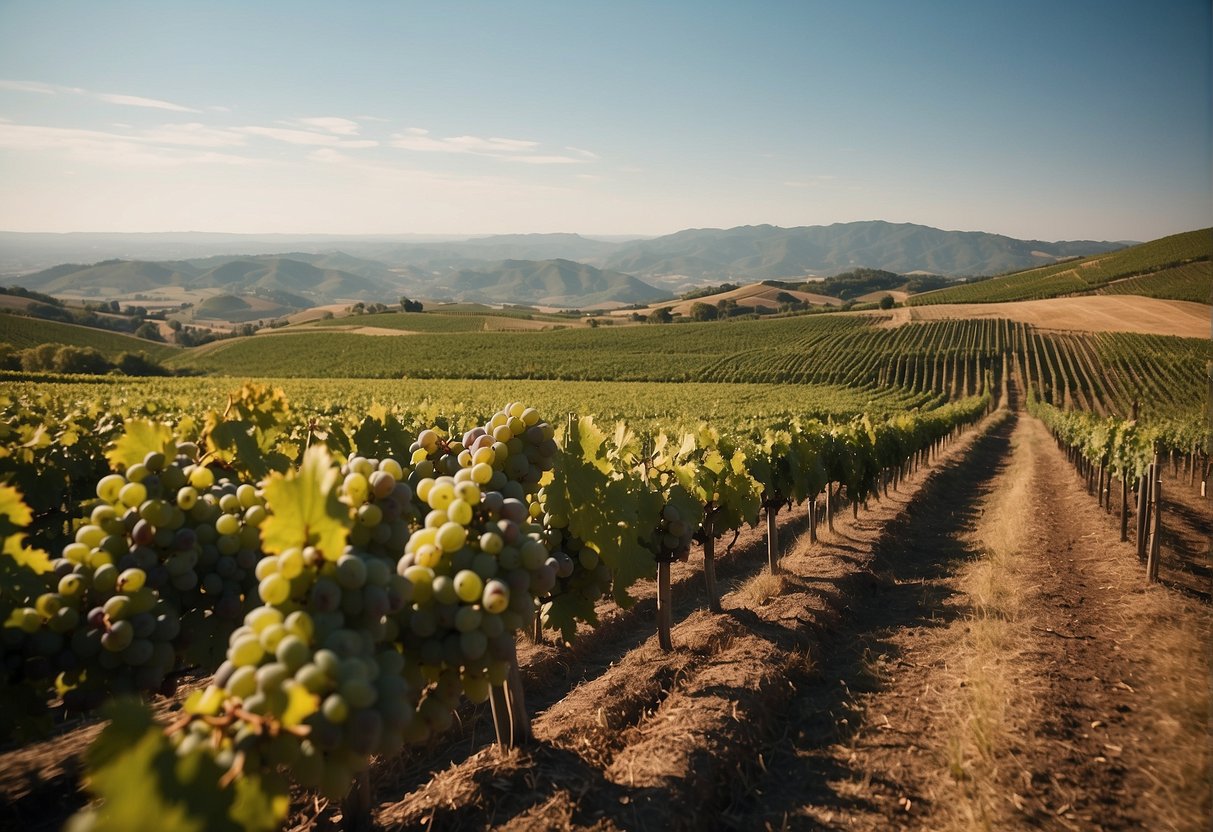
Abruzzo, a region noted for balancing the influences of the Adriatic Sea and the Gran Sasso mountains, is embracing sustainability in wine production.
Your choice to support this region aids in conservation efforts and the movement towards eco-friendly practices.
Organic farming is taking root here, as winemakers recognize your preference for wines produced with minimal intervention.
This shift also ensures that vineyards adapt to varying climate patterns, which is essential for the long-term viability of Abruzzo’s wine industry.
By choosing these wines, you’re part of a larger trend, driving demand for sustainable and ethically-produced beverages.
You’ll find that wineries in Abruzzo are increasingly mindful of rainfall and water use, optimizing irrigation to conserve water. This careful management is crucial given the climate challenges the region faces.
- Innovation: New technologies and ancient techniques blend to create a modern, sustainable winemaking process.
- Biodiversity: Protecting native species and promoting diverse ecosystems among the vineyards.
Winemakers are preparing for the future of wine production by focusing on these key areas:
- Climate Adaptability: Developing robust grape varietals that can thrive in changing weather conditions.
- Water Management: Leveraging rain patterns and reducing water waste through innovative irrigation systems.
- Organic Viticulture: Enhancing soil health and reducing chemical inputs by employing organic farming methods.
Your interest in the Abruzzo wine region contributes to the advancement of these positive trends. Enjoy each sip knowing you support a region invested in the health of the planet and the quality of their wine.
Frequently Asked Questions
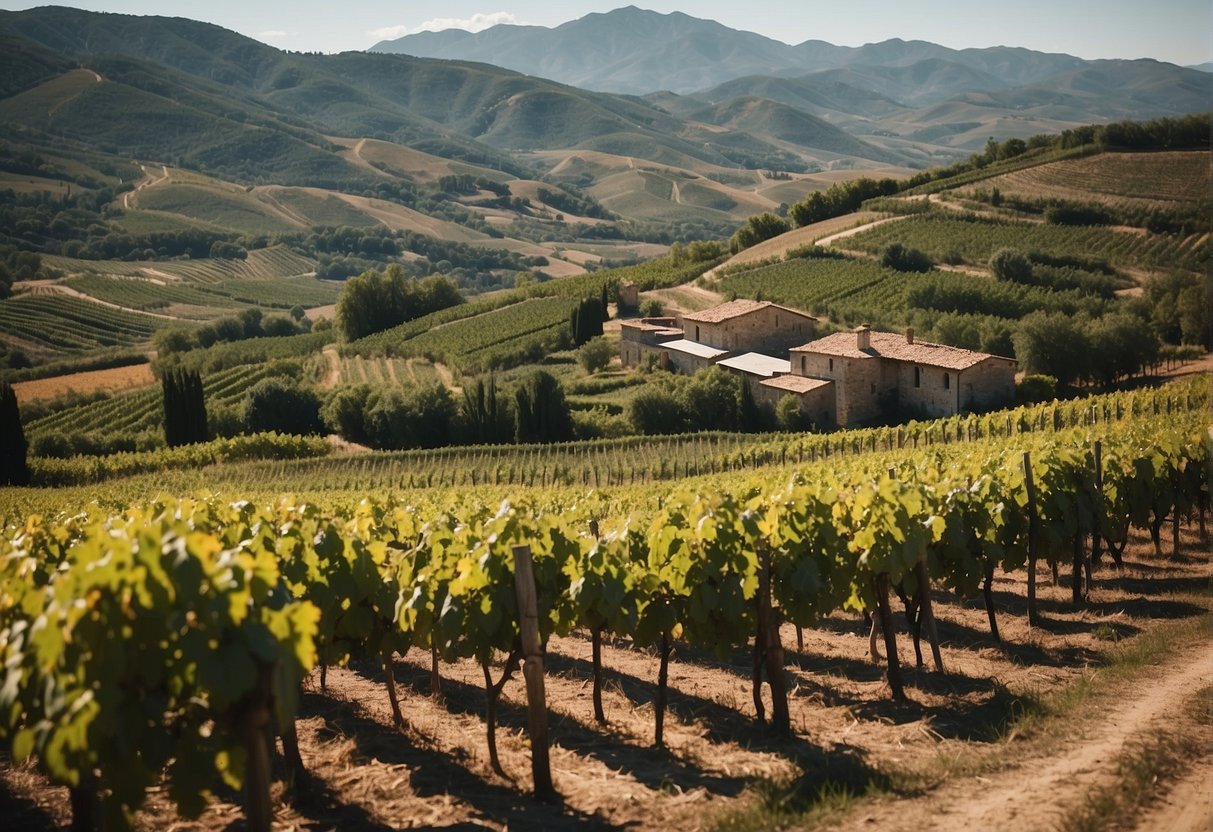
In this section, you’ll find answers to common inquiries about the unique wine varieties and culture within the breathtaking Abruzzo wine region.
What are the distinctive characteristics of red and white wines from the Abruzzo region?
Red wines from Abruzzo, particularly the noted Montepulciano d’Abruzzo, are admired for their bold flavors and ability to age well. They typically have rich berry and spice notes.
On the other hand, the white wines, like Trebbiano d’Abruzzo, are appreciated for their crisp acidity and subtle fruit flavors, making them refreshing to enjoy.
Can you recommend some must-visit towns or cities for wine enthusiasts in Abruzzo?
Certainly! You should consider visiting the medieval village of Pacentro in the L’Aquila province for its vineyards and historic charm.
Another notable destination is Pescara, where you can enjoy beachside tastings.
What distinguishes Montepulciano d’Abruzzo wine, and what might I expect to pay for it?
Montepulciano d’Abruzzo is celebrated for its robust tannins, dark fruit flavors, and earthy undertones.
Prices can vary widely, but you can find a good bottle starting from around 20 USD, with more aged or specialty vintages costing considerably more.
How does the wine culture and production in Abruzzo compare with other Italian regions, such as Tuscany?
Abruzzo has a more rugged terrain with mountainous landscapes influencing its wine profiles, creating distinct flavors from the more rolling hills of Tuscany.
The focus in Abruzzo is often on authenticity and traditional methods, while Tuscany is known for both traditional wines and modern Super Tuscans.
For someone looking to explore Abruzzo’s wineries, what are some top destinations or experiences?
You should explore the Abruzzo wine region, with its diverse wineries along the Adriatic coast and in the Apennine Mountains.
Winery tours and tastings are essential experiences, as is visiting local museums and soaking in the natural beauty of national parks.
In terms of wine varieties, what are some of the best vintages that Abruzzo offers to connoisseurs?
Abruzzo is particularly proud of its Montepulciano and Trebbiano vintages from years that had excellent climate conditions.
Superior Montepulciano vintages often come from years with warm summers and mild autumns. Meanwhile, Trebbiano thrives in slightly cooler vintages.
